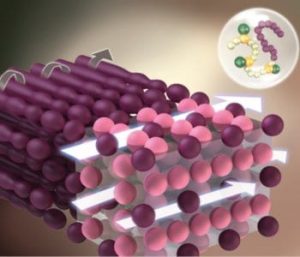 Ion-containing polymers are an interesting class of material with applications in fields like membranes, batteries, packaging and many more. The incorporation of ionic liquids into a polymer has more recently resulted in the formation of a new class of material. Ionic liquids are salts composed of an organic cation and an organic or inorganic anion, which typically have melting points below 100 °C. Unlike conventional ion-containing polymers that are typically constrained to high glass transition temperatures due to strong electrostatic ion pair interactions, polymers with ionic liquids may, if well-designed, possess low glass transition temperatures due to weak electrostatic ion pair interactions, while maintaining high charge densities. With the broad range of possible and unique properties due to the chemical diversity of ionic liquids, as well as the well-developed polymer chemistry and physics, the potential for ionic liquid-based polymers is highly intriguing and almost limitless. A recent special issue in Macromolecular Rapid Communications (guest-edited by Timothy E. Long, Yossef A. Elabd, and Jiayin Yuan) now presents selected highlights in this exciting field.
Ion-containing polymers are an interesting class of material with applications in fields like membranes, batteries, packaging and many more. The incorporation of ionic liquids into a polymer has more recently resulted in the formation of a new class of material. Ionic liquids are salts composed of an organic cation and an organic or inorganic anion, which typically have melting points below 100 °C. Unlike conventional ion-containing polymers that are typically constrained to high glass transition temperatures due to strong electrostatic ion pair interactions, polymers with ionic liquids may, if well-designed, possess low glass transition temperatures due to weak electrostatic ion pair interactions, while maintaining high charge densities. With the broad range of possible and unique properties due to the chemical diversity of ionic liquids, as well as the well-developed polymer chemistry and physics, the potential for ionic liquid-based polymers is highly intriguing and almost limitless. A recent special issue in Macromolecular Rapid Communications (guest-edited by Timothy E. Long, Yossef A. Elabd, and Jiayin Yuan) now presents selected highlights in this exciting field.
Read selected papers of this issue for free for a limited time:
- The Feature Article by Jiayin Yuan and co-workers (Max Planck Institute of Colloids and Interfaces, Potsdam, Germany) provides a detailed look at the current state-of-the-art of the new field of poly(ionic liquid) sensors.
- Hiroyuki Ohno and co-workers (Tokyo University of Agriculture and Technology, Japan) describe a new type of thermoresponsive poly(ionic liquid) gel based on polymerizable phosphonium chloride-type ionic liquid monomers with the long-term goal to desalinate sea water.

















